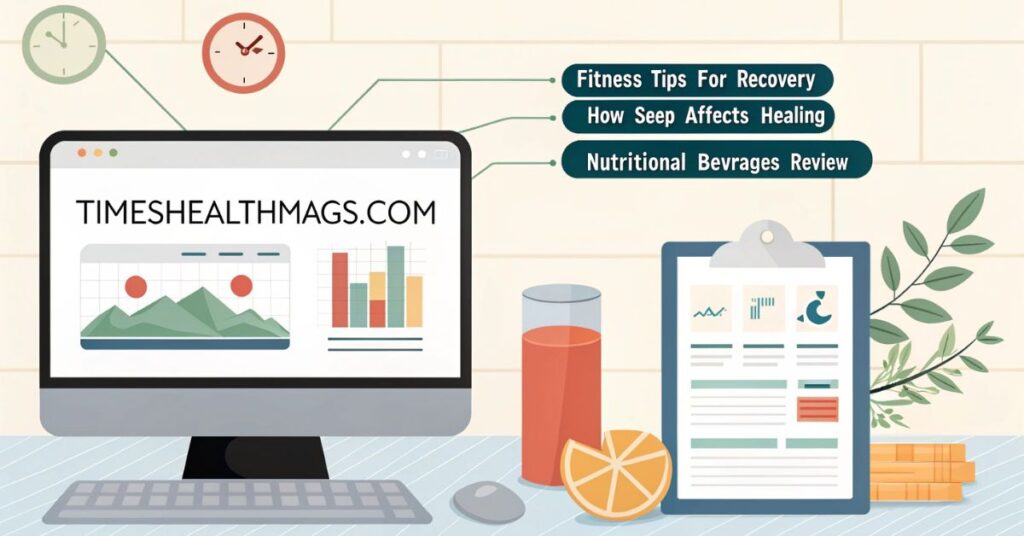In today’s fast-paced world, Americans are turning to digital platforms for guidance on how to live healthier, more balanced lives. Among the rising voices in this space is [timeshealthmags.com], a wellness-focused website carving out a space for itself through diverse health content ranging from fitness to nutrition and holistic living. But how reliable is this site, and does it live up to its growing reputation?
This in-depth article provides a comprehensive review and breakdown of [timeshealthmags.com], exploring everything from content quality and structure to SEO strategies, user trust signals, and its future in the wellness world.
Understand the Brand – Dive Deeper Now
The Emergence of timeshealthmags.com
Launched to offer accessible wellness knowledge, [timeshealthmags.com] entered the digital health scene during a time when more Americans began prioritizing mental and physical well-being. While the website’s exact founding date isn’t broadly publicized, it’s evident that its rise aligns with increasing health awareness trends in the post-pandemic era.

Mission Behind the Platform
At its core, [timeshealthmags.com] is about empowerment. Its content serves individuals who are seeking simple, science-informed tips to boost everyday health. Whether you’re looking to create a diet plan, build a fitness routine, or just better understand how hormones impact your mood, the site aims to be your digital companion.
Explore Content Categories – Take the Tour
H3: Fitness and Exercise Focus
The Fitness & Exercise section covers everything from:
- Training with certified professionals
- Post-rehab and recovery fitness insights
- Psychological benefits of physical activity.
This category leans toward users trying to reclaim fitness post-injury or looking to prevent burnout.
Nutritional Advice and Food Trends
With articles on beverage evaluations, macro-balancing, and whole-food approaches, [timeshealthmags.com] does a decent job blending trending diets with traditional nutritional values. What’s missing, however, is deeper insight into meal planning templates or community-supported diets like paleo or Mediterranean.
Holistic and Mental Wellness
The Wellness Tips & Advice category stands out. Articles discussing sauna dome benefits, hormone imbalance symptoms, and productivity pitfalls make this section highly relatable for American workers balancing stress, tech fatigue, and performance.
Evaluate Article Quality – See for Yourself
Editorial Approach
The writing style across [timeshealthmags.com] is inviting, conversational, and digestible. Most articles span between 800–1200 words and are broken up with subheadings. The reading level is ideal for everyday users—not too academic, but not overly simplified either.
Use of Research and Data
This is where the site could improve. While it occasionally references scientific studies, it often does so without direct source linking. Articles discussing hormone health or diet impact would benefit from hyperlinked peer-reviewed sources to boost credibility.
Author Credentials and Transparency
One of the limitations is the vague author attribution. Many posts lack named authors, bios, or professional affiliations. For health content, transparency is essential for building user trust and domain authority in the long term.
Website Design and Usability – Experience It Now
Mobile Responsiveness
With more than half of web traffic in the USA coming from mobile devices, mobile optimization is critical. Fortunately, [timeshealthmags.com] adapts well to mobile, offering quick loading times and content that doesn’t suffer from formatting glitches.
User Interface and Readability
Simple color schemes, uncluttered design, and clear font choices make reading a pleasure. It avoids flashy pop-ups or overwhelming ad placements, enhancing the user experience.
Accessibility Features
While the site loads quickly and is easy to use, it lacks advanced accessibility features like text-to-speech compatibility or font-resizing buttons that would benefit visually impaired users.
Compare with Competitors – Benchmark It Now
How It Compares to Healthline and WebMD
While [timeshealthmags.com] can’t match the scientific depth or brand trust of giants like WebMD, it holds its own in lifestyle wellness. Its relatable tone and personalized tips feel more human than WebMD’s clinical language.

Niche Focus Makes It Unique
Whereas Healthline or Verywell Health often lean into symptom checkers and condition overviews, [timeshealthmags.com] excels in bridging the gap between science and lifestyle. Think of it more as a health blog than a medical encyclopedia.
Trust Factors and Credibility – Check It Now
Security and Transparency
The site uses HTTPS encryption and has a standard privacy policy. However, it would benefit from adding a disclaimer regarding medical advice and a more visible contact section.
Ad Saturation and Monetization
Currently, ads are minimally invasive, which is great for user experience. If monetization ramps up, maintaining this balance will be critical to avoid driving readers away.
Unique Features That Stand Out – Explore More
H3: Editor’s Picks Section
This hand-curated section features notable articles that receive spotlight treatment. These pieces often address trending topics in a more in-depth format.
H3: Diverse Health Angles
Instead of just focusing on weight loss or generic tips, [timeshealthmags.com] dives into corporate wellness programs, hormone balance, and post-rehab fitness—a move that shows it understands the evolving needs of today’s health-conscious American.
Missed Opportunities – Improve It Now
Absence of Multimedia Content
In 2025, video and podcast content are not just nice to have—they’re expected. The absence of visual or auditory content could be limiting reach, especially among younger, multitasking users.
Lack of Interactive Tools
No BMI calculator, food tracker, or fitness planner makes the platform feel slightly passive. Adding these could enhance engagement and utility.
Minimal Community Features
Unlike platforms with forums or comment sections, [timeshealthmags.com] doesn’t offer space for users to interact or ask questions. A user community would significantly boost retention and trust.
User-Centric Evaluation – Think Like a Reader
Content Freshness
New articles are added regularly, though the update cycle of older content is unclear. Health information evolves fast, and keeping content up to date is vital for maintaining trust.
Engagement Metrics
There’s little public data about time-on-page or social shares, but based on topic relevance and structure, the site is positioned to perform well with health-conscious readers ages 25–55.
FAQs
Q1: Is timeshealthmags.com a credible source for health advice?
Yes, it provides practical wellness information, though more expert attribution and research citations would boost credibility.
Q2: Who is the target audience of timeshealthmags.com?
Primarily American adults interested in wellness, balanced living, and recovery-focused fitness and nutrition.
Q3: Does timeshealthmags.com have an app or podcast?
Currently, there’s no official app or multimedia content. It focuses strictly on written articles.
Q4: Can I trust the nutritional and fitness advice?
For general wellness, yes. But always consult a medical professional before applying advice from any health site.
Q5: How often is the site updated?
New content appears regularly, though the frequency of updates to older articles is not clearly indicated.
Conclusion: Why timeshealthmags.com Matters
[timeshealthmags.com] is a helpful site for anyone in the U.S. looking to live healthier. It shares simple tips on fitness, food, and wellness that are easy to understand and use. The site looks clean, is easy to read, and covers topics that matter to everyday life.
While it could improve by adding expert names, videos, or tools, it still gives solid advice you can trust. If you want a health site that feels friendly and real—not too technical—[timeshealthmags.com] is a great place to start.
Read Also:



































